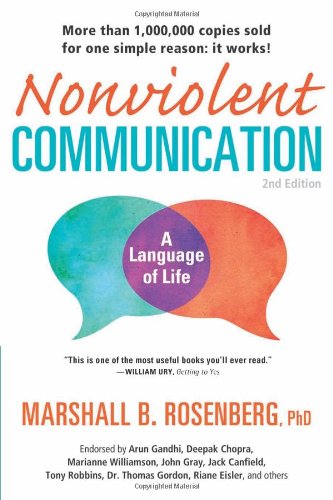Connecting from the Heart:
How to Use Nonviolent Communication
With Our Children
Guest Post by Dave Soleil
On the journey of peaceful parenting, how we communicate and what we communicate with our children is important. But in the middle of our many crazy parenting situations, how can we keep our knee-jerk emotions from running away with our interactions? It can be a real challenge as a parent.
I have found Nonviolent Communication, or NVC, to be incredibly insightful and one of many great tools for communication for parents. The author of NVC is Marshall Rosenberg, who originally did research with Carl Rogers. The foreword to his book, Nonviolent Communication, is by Arun Gandhi, the grandson of Mahatma Gandhi, who calls NVC a natural extension of his grandfather’s philosophy of nonviolence.
The basic idea is that when we feel frustration, anger, sadness or other similar feelings, that they are the result of unmet needs. A common example for parents is when we don’t get enough sleep. During the day, we have a “short fuse” and the everyday challenges of life seem significantly more difficult. The solution is not to blame or shame our children, rather we need to get more sleep. Rest and sleep were unmet needs.
Unmet needs can also be emotional or what in NVC is called “trans-personal.” When your child seemingly ignores every word you say, you feel anger bubbling up. Your child isn’t trying to make you angry. They are fulfilling their own needs like humor, play or exploration. It is simply that your needs and their needs don’t align for that moment. This is natural and happens all the time. So, how can we communicate in ways that connect with the heart and lift each other up?
Rosenberg recommends four steps:
- Needs
What matters to you in this situation? What need is not being met for you? “…because I have a need for…” Safety? Peace? Connection? Autonomy and freedom? Your needs will be very different depending on the situation. Your needs with your child will be very different than when you are out with your friends. This is also an opportunity to hear and acknowledge your child’s feelings and needs. - Observations
We want to stay away from blaming, shaming or attacking others. So, we begin with non-judgmental observations. “When I see you drawing a picture on the wall…” “I remember calling your name and you didn’t answer.” “I heard” or “I saw,” are great starting phrases. - Feelings
What is your feeling? Again, this is about a non-judgmental feeling rather than a thought or interpretation. “I feel frustrated” or “I feel afraid” or angry, sad, tense, or confused. There are dozens of feelings you may have. Own them. It’s ok for your child to see you as a feeling person. You may feel vulnerable. That’s ok too. Connecting with your child from the heart comes from love. Be confident in knowing that you are putting love first in your relationship with your child. - Requests
Make a positive request that would enrich your life without demanding. “Would you be willing to…” or a similar invitation is effective. “Stop it” is a demand rather than a positive request, even if you say it nicely.
So, here’s an example pulling it all together. Your three-year old is balancing on the arm of a rocking chair.
Parent: “Sweetie, when you stand on the rocking chair, I feel afraid because I have a need for safety. You matter to me and I don’t want you to get hurt. Would you be willing to balance outside or somewhere safer?”
Child: “But I want to play!”
Parent: “I hear that you have a need to play right now. What if I set up a balance beam outside for you? Would you like to use that?”
Child: “Yeah!”
The four steps may feel a bit awkward. That’s ok. NVC helps interrupt that emotional “Get down!” or “Stop that, you’ll break your neck!” NVC is a way of communicating that puts your relationship first. It can be effective with any age person whether they are family or co-workers or just someone you bumped into at the grocery store.
I think you’ll discover some beautiful moments with your children using NVC. They will recognize the efforts you are making, even if they are awkward and imperfect. Your relationships will deepen with each interaction and bring you closer together.
If you want to learn more about NVC and how to use it, check out these resources:
 Nonviolent Communication, Book by Marshall Rosenberg
Nonviolent Communication, Book by Marshall Rosenberg
The Center for Nonviolent Communication
Three-Hour workshop by Marshall Rosenberg on YouTube
Dave Soleil is a leadership education consultant specializing in the philosophy, methodology and spirituality of Nonviolence. David has over twenty years of experience designing and delivering leadership programs for nonprofits, educational institutions and corporate groups. He is also a founder and staff member at the Sudbury School of Atlanta, where the staff uses Nonviolent Communication with students to resolve conflicts. Dave has two daughters, ages 5 & 8, who help him daily along his journey to become a more compassionate parent.
